Medication Safety: Strategies for Improvement and Analysis Report
VerifiedAdded on 2023/01/12
|10
|2922
|36
Report
AI Summary
This report provides a comprehensive overview of medication safety, emphasizing its critical role in healthcare to prevent preventable harm and improve patient outcomes. It defines medication safety and medication errors, highlighting the significance of effective medication use. The report explores the reasons behind medication errors, including discrepancies during hospital admission, discharge, and transitions of care, and the impact of medication inconsistencies. It then details strategies for improving medication safety, such as updated medication references, understanding patient conditions, and implementing health information technology. Strengths of medication safety, such as reducing errors and patient education, are discussed, along with weaknesses like patient characteristics and reluctance to change medication. The report concludes by reiterating the importance of medication safety in clinical practice and its contribution to patient trust and effective treatment.
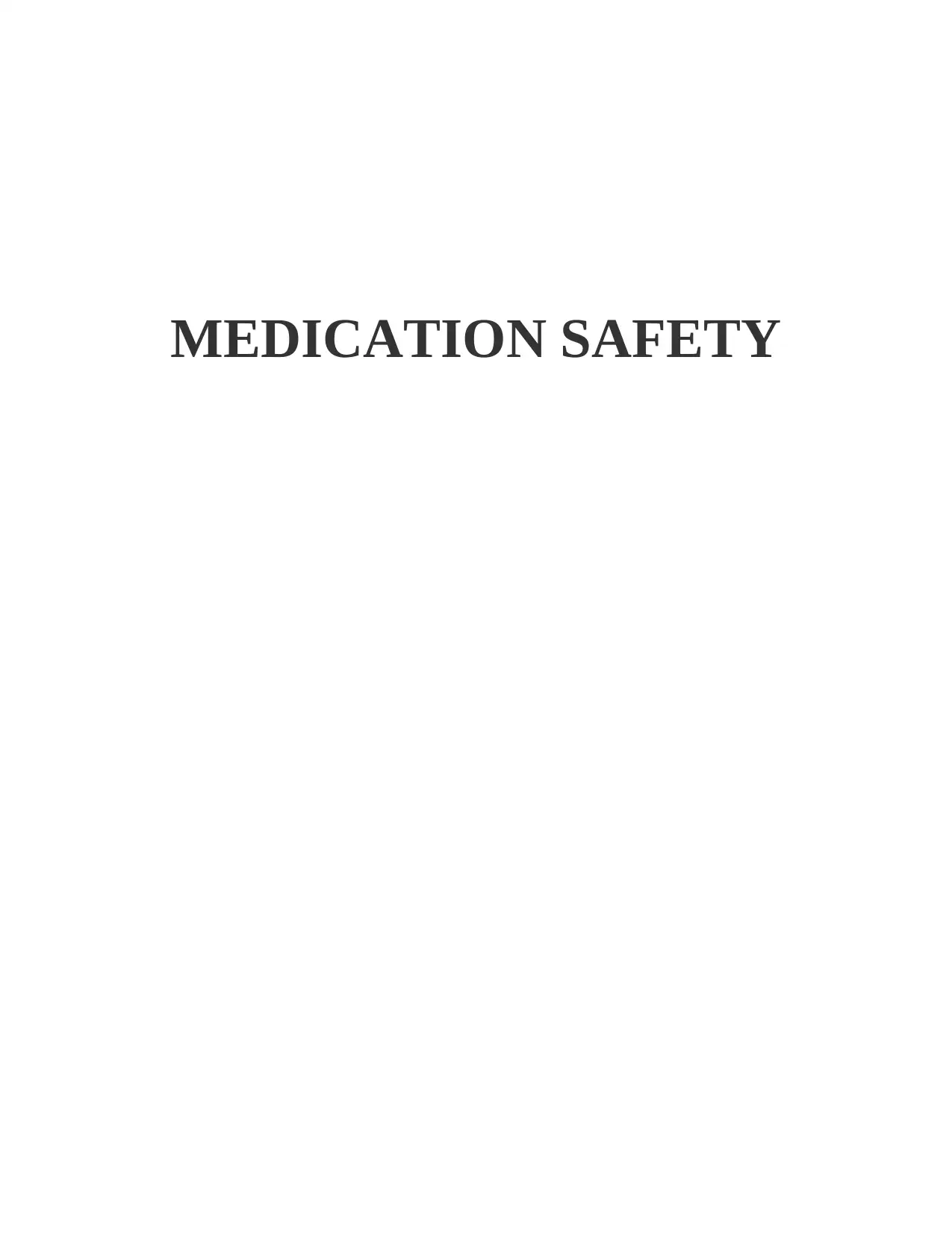
MEDICATION SAFETY
Paraphrase This Document
Need a fresh take? Get an instant paraphrase of this document with our AI Paraphraser
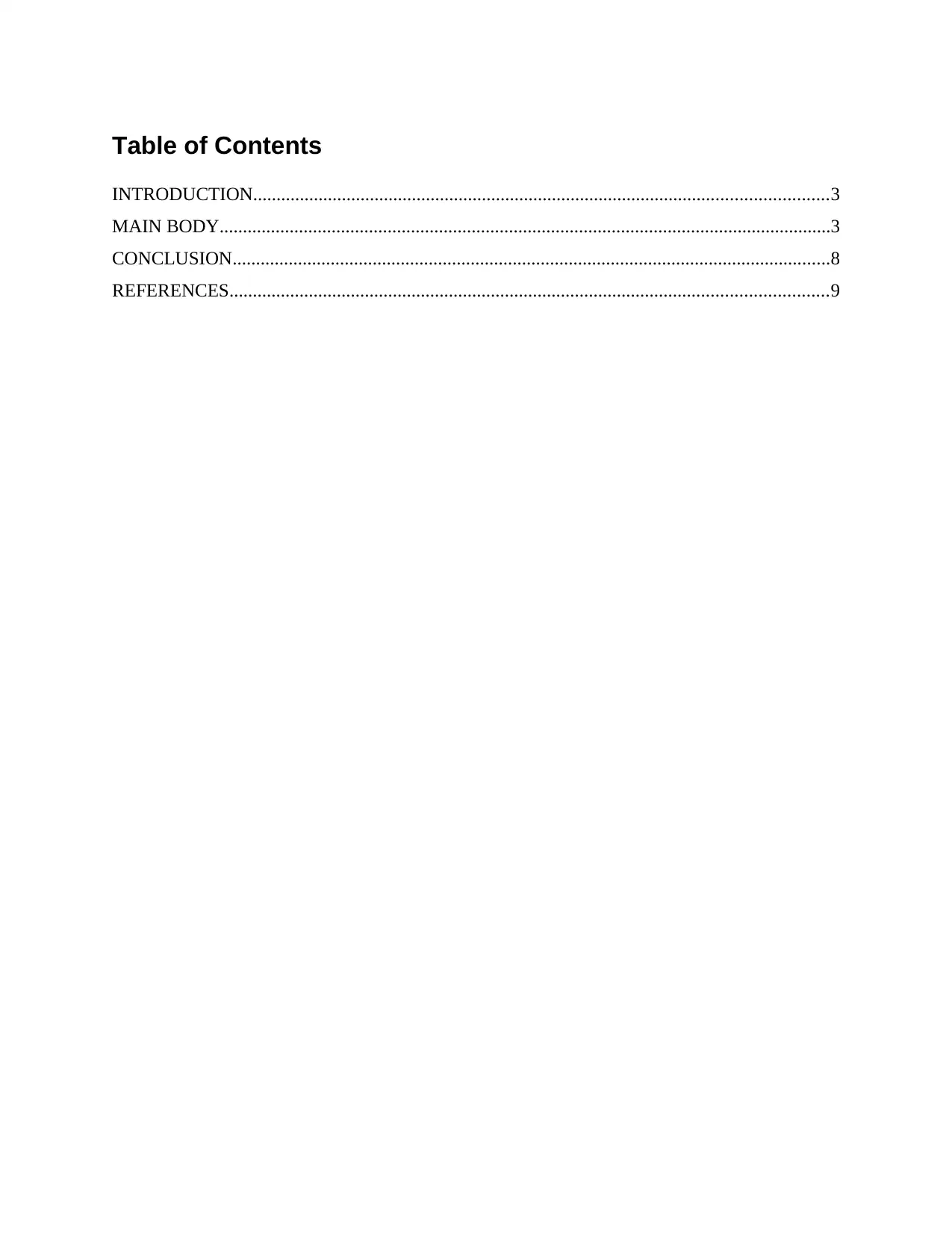
Table of Contents
INTRODUCTION...........................................................................................................................3
MAIN BODY...................................................................................................................................3
CONCLUSION................................................................................................................................8
REFERENCES................................................................................................................................9
INTRODUCTION...........................................................................................................................3
MAIN BODY...................................................................................................................................3
CONCLUSION................................................................................................................................8
REFERENCES................................................................................................................................9
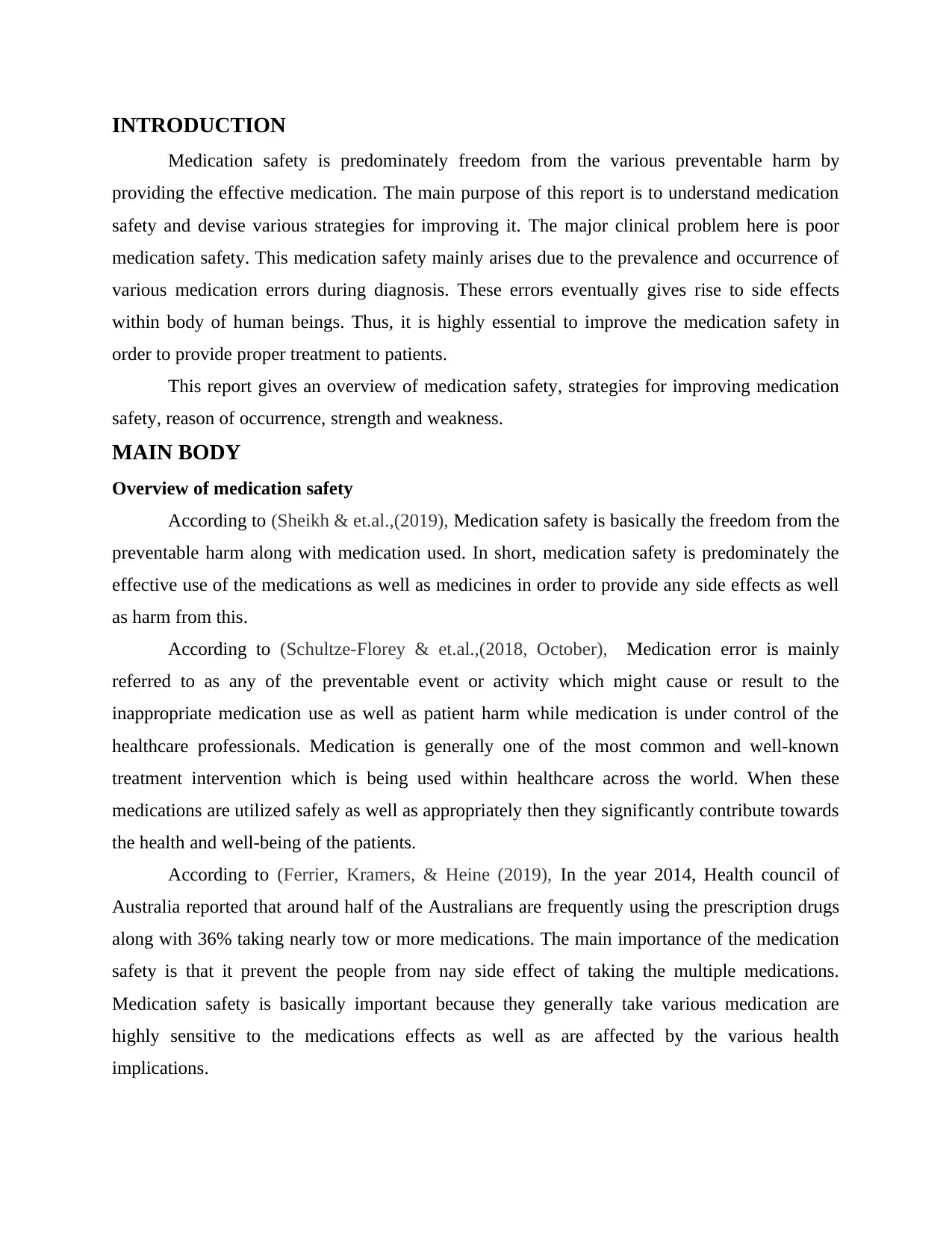
INTRODUCTION
Medication safety is predominately freedom from the various preventable harm by
providing the effective medication. The main purpose of this report is to understand medication
safety and devise various strategies for improving it. The major clinical problem here is poor
medication safety. This medication safety mainly arises due to the prevalence and occurrence of
various medication errors during diagnosis. These errors eventually gives rise to side effects
within body of human beings. Thus, it is highly essential to improve the medication safety in
order to provide proper treatment to patients.
This report gives an overview of medication safety, strategies for improving medication
safety, reason of occurrence, strength and weakness.
MAIN BODY
Overview of medication safety
According to (Sheikh & et.al.,(2019), Medication safety is basically the freedom from the
preventable harm along with medication used. In short, medication safety is predominately the
effective use of the medications as well as medicines in order to provide any side effects as well
as harm from this.
According to (Schultze-Florey & et.al.,(2018, October), Medication error is mainly
referred to as any of the preventable event or activity which might cause or result to the
inappropriate medication use as well as patient harm while medication is under control of the
healthcare professionals. Medication is generally one of the most common and well-known
treatment intervention which is being used within healthcare across the world. When these
medications are utilized safely as well as appropriately then they significantly contribute towards
the health and well-being of the patients.
According to (Ferrier, Kramers, & Heine (2019), In the year 2014, Health council of
Australia reported that around half of the Australians are frequently using the prescription drugs
along with 36% taking nearly tow or more medications. The main importance of the medication
safety is that it prevent the people from nay side effect of taking the multiple medications.
Medication safety is basically important because they generally take various medication are
highly sensitive to the medications effects as well as are affected by the various health
implications.
Medication safety is predominately freedom from the various preventable harm by
providing the effective medication. The main purpose of this report is to understand medication
safety and devise various strategies for improving it. The major clinical problem here is poor
medication safety. This medication safety mainly arises due to the prevalence and occurrence of
various medication errors during diagnosis. These errors eventually gives rise to side effects
within body of human beings. Thus, it is highly essential to improve the medication safety in
order to provide proper treatment to patients.
This report gives an overview of medication safety, strategies for improving medication
safety, reason of occurrence, strength and weakness.
MAIN BODY
Overview of medication safety
According to (Sheikh & et.al.,(2019), Medication safety is basically the freedom from the
preventable harm along with medication used. In short, medication safety is predominately the
effective use of the medications as well as medicines in order to provide any side effects as well
as harm from this.
According to (Schultze-Florey & et.al.,(2018, October), Medication error is mainly
referred to as any of the preventable event or activity which might cause or result to the
inappropriate medication use as well as patient harm while medication is under control of the
healthcare professionals. Medication is generally one of the most common and well-known
treatment intervention which is being used within healthcare across the world. When these
medications are utilized safely as well as appropriately then they significantly contribute towards
the health and well-being of the patients.
According to (Ferrier, Kramers, & Heine (2019), In the year 2014, Health council of
Australia reported that around half of the Australians are frequently using the prescription drugs
along with 36% taking nearly tow or more medications. The main importance of the medication
safety is that it prevent the people from nay side effect of taking the multiple medications.
Medication safety is basically important because they generally take various medication are
highly sensitive to the medications effects as well as are affected by the various health
implications.
⊘ This is a preview!⊘
Do you want full access?
Subscribe today to unlock all pages.

Trusted by 1+ million students worldwide
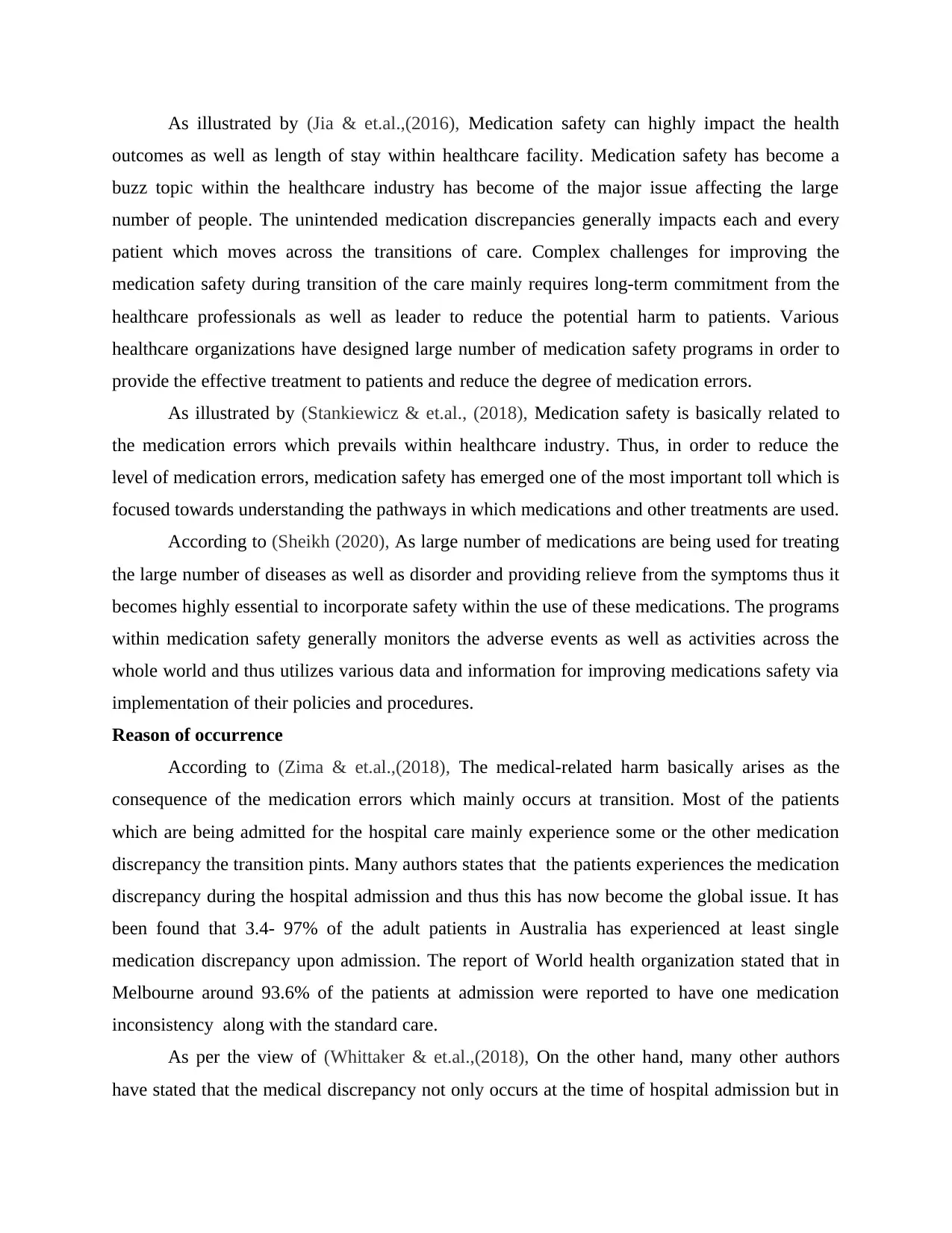
As illustrated by (Jia & et.al.,(2016), Medication safety can highly impact the health
outcomes as well as length of stay within healthcare facility. Medication safety has become a
buzz topic within the healthcare industry has become of the major issue affecting the large
number of people. The unintended medication discrepancies generally impacts each and every
patient which moves across the transitions of care. Complex challenges for improving the
medication safety during transition of the care mainly requires long-term commitment from the
healthcare professionals as well as leader to reduce the potential harm to patients. Various
healthcare organizations have designed large number of medication safety programs in order to
provide the effective treatment to patients and reduce the degree of medication errors.
As illustrated by (Stankiewicz & et.al., (2018), Medication safety is basically related to
the medication errors which prevails within healthcare industry. Thus, in order to reduce the
level of medication errors, medication safety has emerged one of the most important toll which is
focused towards understanding the pathways in which medications and other treatments are used.
According to (Sheikh (2020), As large number of medications are being used for treating
the large number of diseases as well as disorder and providing relieve from the symptoms thus it
becomes highly essential to incorporate safety within the use of these medications. The programs
within medication safety generally monitors the adverse events as well as activities across the
whole world and thus utilizes various data and information for improving medications safety via
implementation of their policies and procedures.
Reason of occurrence
According to (Zima & et.al.,(2018), The medical-related harm basically arises as the
consequence of the medication errors which mainly occurs at transition. Most of the patients
which are being admitted for the hospital care mainly experience some or the other medication
discrepancy the transition pints. Many authors states that the patients experiences the medication
discrepancy during the hospital admission and thus this has now become the global issue. It has
been found that 3.4- 97% of the adult patients in Australia has experienced at least single
medication discrepancy upon admission. The report of World health organization stated that in
Melbourne around 93.6% of the patients at admission were reported to have one medication
inconsistency along with the standard care.
As per the view of (Whittaker & et.al.,(2018), On the other hand, many other authors
have stated that the medical discrepancy not only occurs at the time of hospital admission but in
outcomes as well as length of stay within healthcare facility. Medication safety has become a
buzz topic within the healthcare industry has become of the major issue affecting the large
number of people. The unintended medication discrepancies generally impacts each and every
patient which moves across the transitions of care. Complex challenges for improving the
medication safety during transition of the care mainly requires long-term commitment from the
healthcare professionals as well as leader to reduce the potential harm to patients. Various
healthcare organizations have designed large number of medication safety programs in order to
provide the effective treatment to patients and reduce the degree of medication errors.
As illustrated by (Stankiewicz & et.al., (2018), Medication safety is basically related to
the medication errors which prevails within healthcare industry. Thus, in order to reduce the
level of medication errors, medication safety has emerged one of the most important toll which is
focused towards understanding the pathways in which medications and other treatments are used.
According to (Sheikh (2020), As large number of medications are being used for treating
the large number of diseases as well as disorder and providing relieve from the symptoms thus it
becomes highly essential to incorporate safety within the use of these medications. The programs
within medication safety generally monitors the adverse events as well as activities across the
whole world and thus utilizes various data and information for improving medications safety via
implementation of their policies and procedures.
Reason of occurrence
According to (Zima & et.al.,(2018), The medical-related harm basically arises as the
consequence of the medication errors which mainly occurs at transition. Most of the patients
which are being admitted for the hospital care mainly experience some or the other medication
discrepancy the transition pints. Many authors states that the patients experiences the medication
discrepancy during the hospital admission and thus this has now become the global issue. It has
been found that 3.4- 97% of the adult patients in Australia has experienced at least single
medication discrepancy upon admission. The report of World health organization stated that in
Melbourne around 93.6% of the patients at admission were reported to have one medication
inconsistency along with the standard care.
As per the view of (Whittaker & et.al.,(2018), On the other hand, many other authors
have stated that the medical discrepancy not only occurs at the time of hospital admission but in
Paraphrase This Document
Need a fresh take? Get an instant paraphrase of this document with our AI Paraphraser
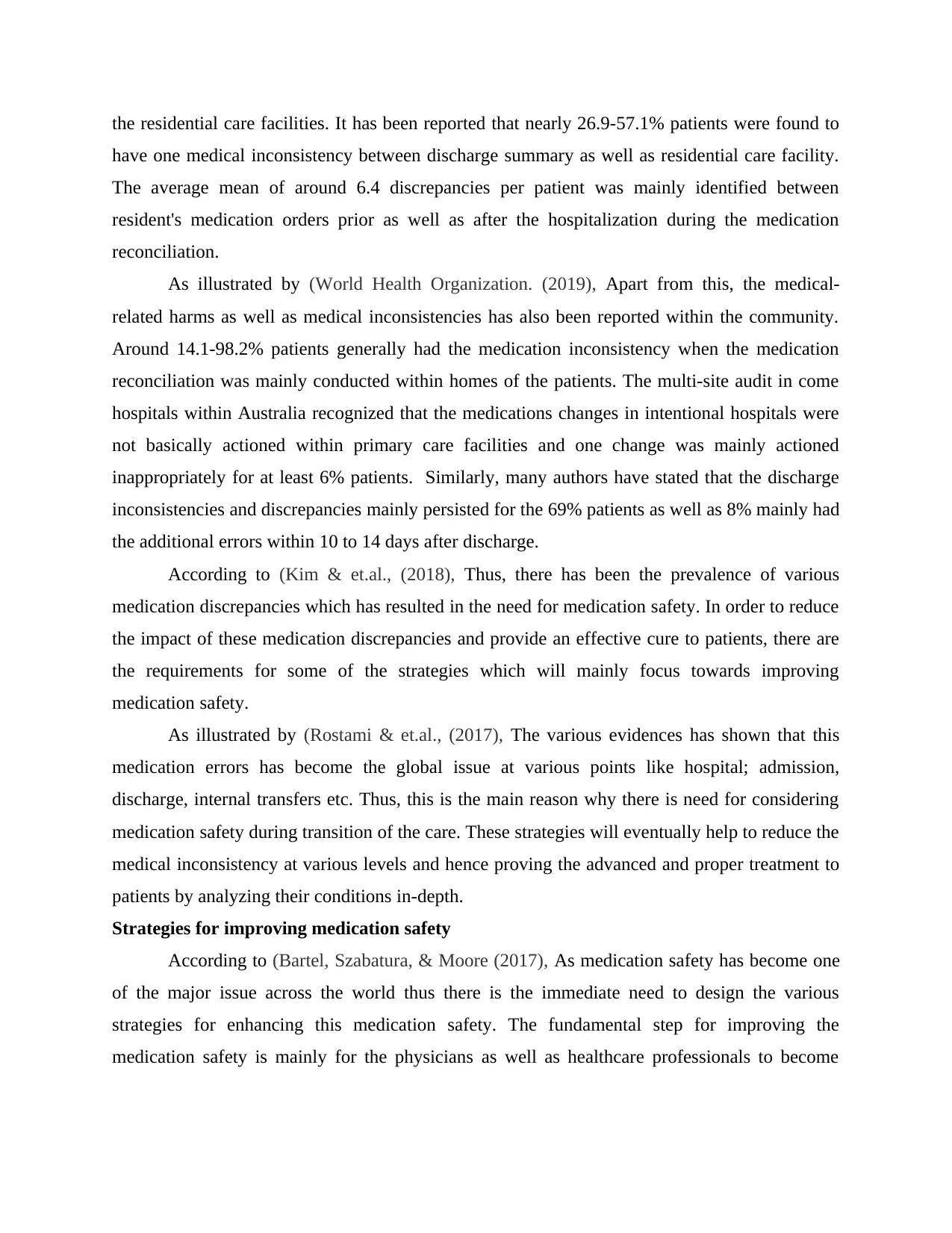
the residential care facilities. It has been reported that nearly 26.9-57.1% patients were found to
have one medical inconsistency between discharge summary as well as residential care facility.
The average mean of around 6.4 discrepancies per patient was mainly identified between
resident's medication orders prior as well as after the hospitalization during the medication
reconciliation.
As illustrated by (World Health Organization. (2019), Apart from this, the medical-
related harms as well as medical inconsistencies has also been reported within the community.
Around 14.1-98.2% patients generally had the medication inconsistency when the medication
reconciliation was mainly conducted within homes of the patients. The multi-site audit in come
hospitals within Australia recognized that the medications changes in intentional hospitals were
not basically actioned within primary care facilities and one change was mainly actioned
inappropriately for at least 6% patients. Similarly, many authors have stated that the discharge
inconsistencies and discrepancies mainly persisted for the 69% patients as well as 8% mainly had
the additional errors within 10 to 14 days after discharge.
According to (Kim & et.al., (2018), Thus, there has been the prevalence of various
medication discrepancies which has resulted in the need for medication safety. In order to reduce
the impact of these medication discrepancies and provide an effective cure to patients, there are
the requirements for some of the strategies which will mainly focus towards improving
medication safety.
As illustrated by (Rostami & et.al., (2017), The various evidences has shown that this
medication errors has become the global issue at various points like hospital; admission,
discharge, internal transfers etc. Thus, this is the main reason why there is need for considering
medication safety during transition of the care. These strategies will eventually help to reduce the
medical inconsistency at various levels and hence proving the advanced and proper treatment to
patients by analyzing their conditions in-depth.
Strategies for improving medication safety
According to (Bartel, Szabatura, & Moore (2017), As medication safety has become one
of the major issue across the world thus there is the immediate need to design the various
strategies for enhancing this medication safety. The fundamental step for improving the
medication safety is mainly for the physicians as well as healthcare professionals to become
have one medical inconsistency between discharge summary as well as residential care facility.
The average mean of around 6.4 discrepancies per patient was mainly identified between
resident's medication orders prior as well as after the hospitalization during the medication
reconciliation.
As illustrated by (World Health Organization. (2019), Apart from this, the medical-
related harms as well as medical inconsistencies has also been reported within the community.
Around 14.1-98.2% patients generally had the medication inconsistency when the medication
reconciliation was mainly conducted within homes of the patients. The multi-site audit in come
hospitals within Australia recognized that the medications changes in intentional hospitals were
not basically actioned within primary care facilities and one change was mainly actioned
inappropriately for at least 6% patients. Similarly, many authors have stated that the discharge
inconsistencies and discrepancies mainly persisted for the 69% patients as well as 8% mainly had
the additional errors within 10 to 14 days after discharge.
According to (Kim & et.al., (2018), Thus, there has been the prevalence of various
medication discrepancies which has resulted in the need for medication safety. In order to reduce
the impact of these medication discrepancies and provide an effective cure to patients, there are
the requirements for some of the strategies which will mainly focus towards improving
medication safety.
As illustrated by (Rostami & et.al., (2017), The various evidences has shown that this
medication errors has become the global issue at various points like hospital; admission,
discharge, internal transfers etc. Thus, this is the main reason why there is need for considering
medication safety during transition of the care. These strategies will eventually help to reduce the
medical inconsistency at various levels and hence proving the advanced and proper treatment to
patients by analyzing their conditions in-depth.
Strategies for improving medication safety
According to (Bartel, Szabatura, & Moore (2017), As medication safety has become one
of the major issue across the world thus there is the immediate need to design the various
strategies for enhancing this medication safety. The fundamental step for improving the
medication safety is mainly for the physicians as well as healthcare professionals to become
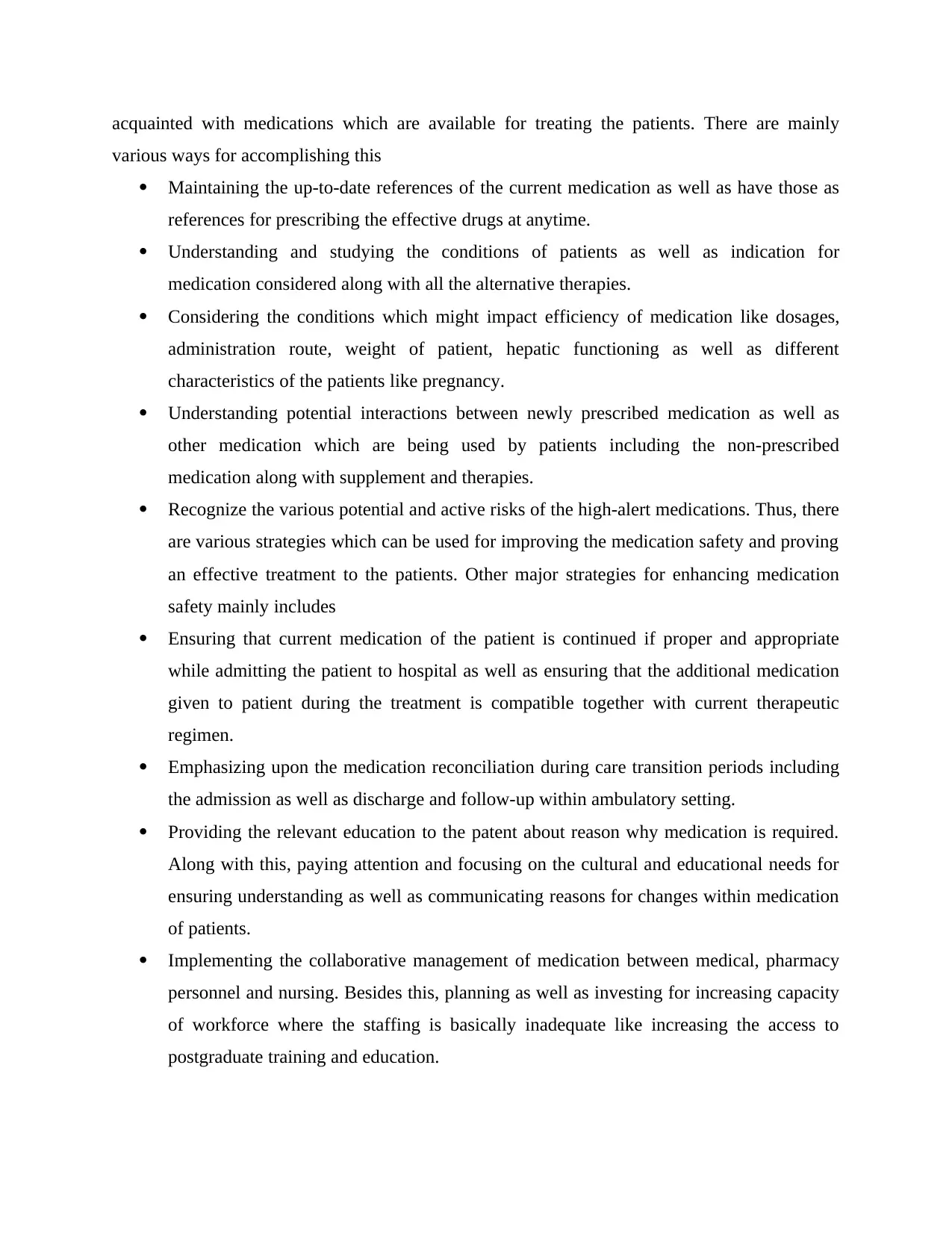
acquainted with medications which are available for treating the patients. There are mainly
various ways for accomplishing this
Maintaining the up-to-date references of the current medication as well as have those as
references for prescribing the effective drugs at anytime.
Understanding and studying the conditions of patients as well as indication for
medication considered along with all the alternative therapies.
Considering the conditions which might impact efficiency of medication like dosages,
administration route, weight of patient, hepatic functioning as well as different
characteristics of the patients like pregnancy.
Understanding potential interactions between newly prescribed medication as well as
other medication which are being used by patients including the non-prescribed
medication along with supplement and therapies.
Recognize the various potential and active risks of the high-alert medications. Thus, there
are various strategies which can be used for improving the medication safety and proving
an effective treatment to the patients. Other major strategies for enhancing medication
safety mainly includes
Ensuring that current medication of the patient is continued if proper and appropriate
while admitting the patient to hospital as well as ensuring that the additional medication
given to patient during the treatment is compatible together with current therapeutic
regimen.
Emphasizing upon the medication reconciliation during care transition periods including
the admission as well as discharge and follow-up within ambulatory setting.
Providing the relevant education to the patent about reason why medication is required.
Along with this, paying attention and focusing on the cultural and educational needs for
ensuring understanding as well as communicating reasons for changes within medication
of patients.
Implementing the collaborative management of medication between medical, pharmacy
personnel and nursing. Besides this, planning as well as investing for increasing capacity
of workforce where the staffing is basically inadequate like increasing the access to
postgraduate training and education.
various ways for accomplishing this
Maintaining the up-to-date references of the current medication as well as have those as
references for prescribing the effective drugs at anytime.
Understanding and studying the conditions of patients as well as indication for
medication considered along with all the alternative therapies.
Considering the conditions which might impact efficiency of medication like dosages,
administration route, weight of patient, hepatic functioning as well as different
characteristics of the patients like pregnancy.
Understanding potential interactions between newly prescribed medication as well as
other medication which are being used by patients including the non-prescribed
medication along with supplement and therapies.
Recognize the various potential and active risks of the high-alert medications. Thus, there
are various strategies which can be used for improving the medication safety and proving
an effective treatment to the patients. Other major strategies for enhancing medication
safety mainly includes
Ensuring that current medication of the patient is continued if proper and appropriate
while admitting the patient to hospital as well as ensuring that the additional medication
given to patient during the treatment is compatible together with current therapeutic
regimen.
Emphasizing upon the medication reconciliation during care transition periods including
the admission as well as discharge and follow-up within ambulatory setting.
Providing the relevant education to the patent about reason why medication is required.
Along with this, paying attention and focusing on the cultural and educational needs for
ensuring understanding as well as communicating reasons for changes within medication
of patients.
Implementing the collaborative management of medication between medical, pharmacy
personnel and nursing. Besides this, planning as well as investing for increasing capacity
of workforce where the staffing is basically inadequate like increasing the access to
postgraduate training and education.
⊘ This is a preview!⊘
Do you want full access?
Subscribe today to unlock all pages.

Trusted by 1+ million students worldwide
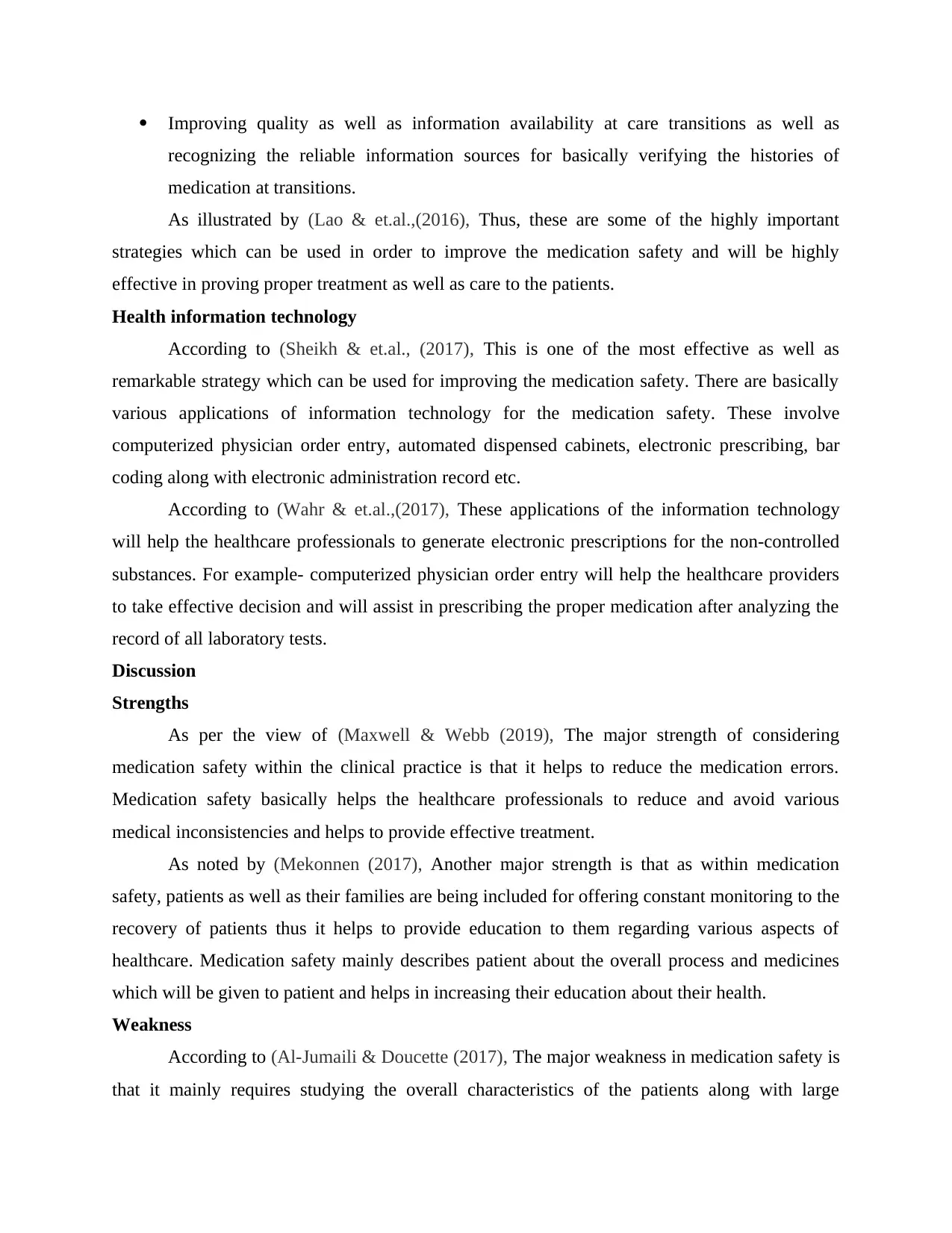
Improving quality as well as information availability at care transitions as well as
recognizing the reliable information sources for basically verifying the histories of
medication at transitions.
As illustrated by (Lao & et.al.,(2016), Thus, these are some of the highly important
strategies which can be used in order to improve the medication safety and will be highly
effective in proving proper treatment as well as care to the patients.
Health information technology
According to (Sheikh & et.al., (2017), This is one of the most effective as well as
remarkable strategy which can be used for improving the medication safety. There are basically
various applications of information technology for the medication safety. These involve
computerized physician order entry, automated dispensed cabinets, electronic prescribing, bar
coding along with electronic administration record etc.
According to (Wahr & et.al.,(2017), These applications of the information technology
will help the healthcare professionals to generate electronic prescriptions for the non-controlled
substances. For example- computerized physician order entry will help the healthcare providers
to take effective decision and will assist in prescribing the proper medication after analyzing the
record of all laboratory tests.
Discussion
Strengths
As per the view of (Maxwell & Webb (2019), The major strength of considering
medication safety within the clinical practice is that it helps to reduce the medication errors.
Medication safety basically helps the healthcare professionals to reduce and avoid various
medical inconsistencies and helps to provide effective treatment.
As noted by (Mekonnen (2017), Another major strength is that as within medication
safety, patients as well as their families are being included for offering constant monitoring to the
recovery of patients thus it helps to provide education to them regarding various aspects of
healthcare. Medication safety mainly describes patient about the overall process and medicines
which will be given to patient and helps in increasing their education about their health.
Weakness
According to (Al-Jumaili & Doucette (2017), The major weakness in medication safety is
that it mainly requires studying the overall characteristics of the patients along with large
recognizing the reliable information sources for basically verifying the histories of
medication at transitions.
As illustrated by (Lao & et.al.,(2016), Thus, these are some of the highly important
strategies which can be used in order to improve the medication safety and will be highly
effective in proving proper treatment as well as care to the patients.
Health information technology
According to (Sheikh & et.al., (2017), This is one of the most effective as well as
remarkable strategy which can be used for improving the medication safety. There are basically
various applications of information technology for the medication safety. These involve
computerized physician order entry, automated dispensed cabinets, electronic prescribing, bar
coding along with electronic administration record etc.
According to (Wahr & et.al.,(2017), These applications of the information technology
will help the healthcare professionals to generate electronic prescriptions for the non-controlled
substances. For example- computerized physician order entry will help the healthcare providers
to take effective decision and will assist in prescribing the proper medication after analyzing the
record of all laboratory tests.
Discussion
Strengths
As per the view of (Maxwell & Webb (2019), The major strength of considering
medication safety within the clinical practice is that it helps to reduce the medication errors.
Medication safety basically helps the healthcare professionals to reduce and avoid various
medical inconsistencies and helps to provide effective treatment.
As noted by (Mekonnen (2017), Another major strength is that as within medication
safety, patients as well as their families are being included for offering constant monitoring to the
recovery of patients thus it helps to provide education to them regarding various aspects of
healthcare. Medication safety mainly describes patient about the overall process and medicines
which will be given to patient and helps in increasing their education about their health.
Weakness
According to (Al-Jumaili & Doucette (2017), The major weakness in medication safety is
that it mainly requires studying the overall characteristics of the patients along with large
Paraphrase This Document
Need a fresh take? Get an instant paraphrase of this document with our AI Paraphraser
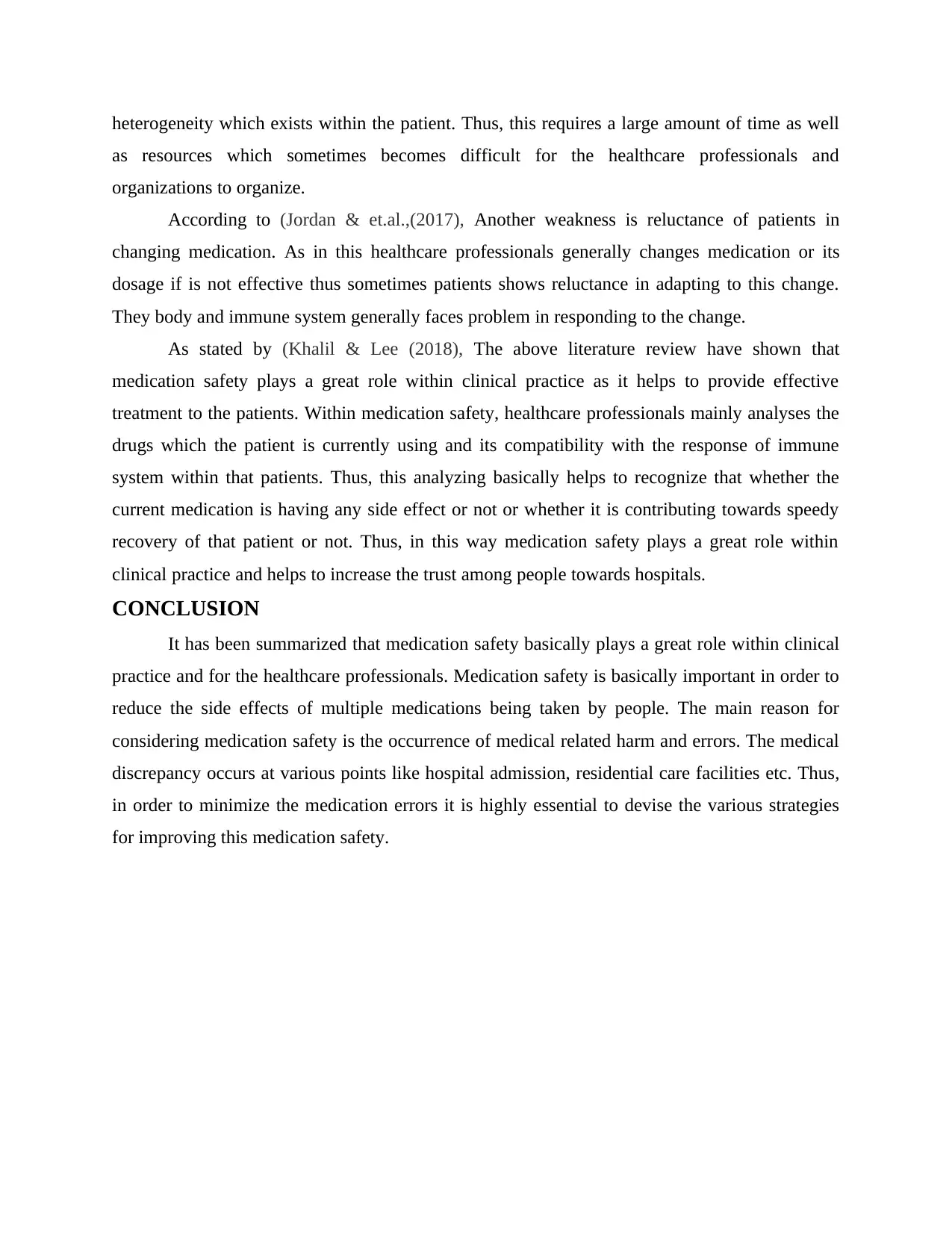
heterogeneity which exists within the patient. Thus, this requires a large amount of time as well
as resources which sometimes becomes difficult for the healthcare professionals and
organizations to organize.
According to (Jordan & et.al.,(2017), Another weakness is reluctance of patients in
changing medication. As in this healthcare professionals generally changes medication or its
dosage if is not effective thus sometimes patients shows reluctance in adapting to this change.
They body and immune system generally faces problem in responding to the change.
As stated by (Khalil & Lee (2018), The above literature review have shown that
medication safety plays a great role within clinical practice as it helps to provide effective
treatment to the patients. Within medication safety, healthcare professionals mainly analyses the
drugs which the patient is currently using and its compatibility with the response of immune
system within that patients. Thus, this analyzing basically helps to recognize that whether the
current medication is having any side effect or not or whether it is contributing towards speedy
recovery of that patient or not. Thus, in this way medication safety plays a great role within
clinical practice and helps to increase the trust among people towards hospitals.
CONCLUSION
It has been summarized that medication safety basically plays a great role within clinical
practice and for the healthcare professionals. Medication safety is basically important in order to
reduce the side effects of multiple medications being taken by people. The main reason for
considering medication safety is the occurrence of medical related harm and errors. The medical
discrepancy occurs at various points like hospital admission, residential care facilities etc. Thus,
in order to minimize the medication errors it is highly essential to devise the various strategies
for improving this medication safety.
as resources which sometimes becomes difficult for the healthcare professionals and
organizations to organize.
According to (Jordan & et.al.,(2017), Another weakness is reluctance of patients in
changing medication. As in this healthcare professionals generally changes medication or its
dosage if is not effective thus sometimes patients shows reluctance in adapting to this change.
They body and immune system generally faces problem in responding to the change.
As stated by (Khalil & Lee (2018), The above literature review have shown that
medication safety plays a great role within clinical practice as it helps to provide effective
treatment to the patients. Within medication safety, healthcare professionals mainly analyses the
drugs which the patient is currently using and its compatibility with the response of immune
system within that patients. Thus, this analyzing basically helps to recognize that whether the
current medication is having any side effect or not or whether it is contributing towards speedy
recovery of that patient or not. Thus, in this way medication safety plays a great role within
clinical practice and helps to increase the trust among people towards hospitals.
CONCLUSION
It has been summarized that medication safety basically plays a great role within clinical
practice and for the healthcare professionals. Medication safety is basically important in order to
reduce the side effects of multiple medications being taken by people. The main reason for
considering medication safety is the occurrence of medical related harm and errors. The medical
discrepancy occurs at various points like hospital admission, residential care facilities etc. Thus,
in order to minimize the medication errors it is highly essential to devise the various strategies
for improving this medication safety.
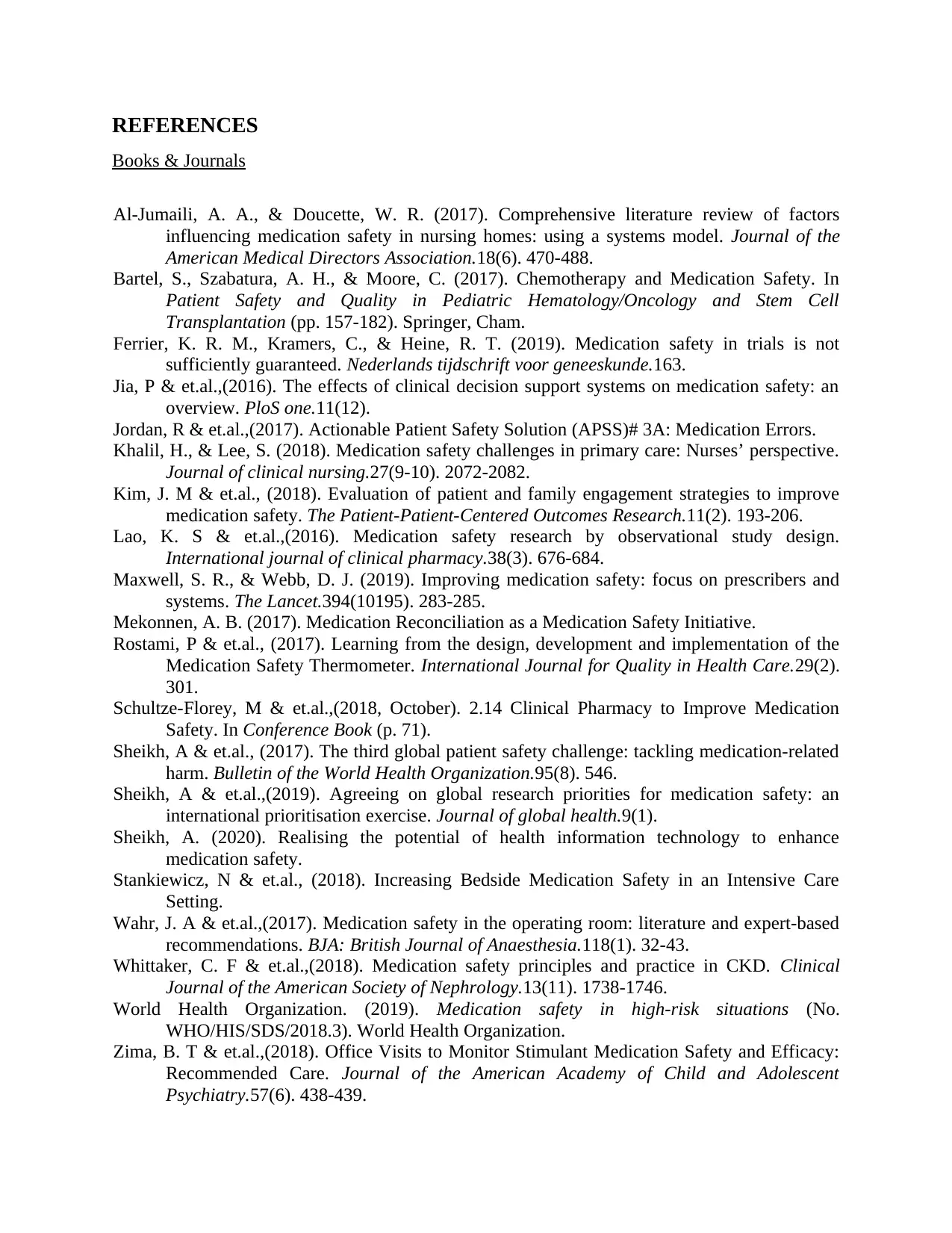
REFERENCES
Books & Journals
Al-Jumaili, A. A., & Doucette, W. R. (2017). Comprehensive literature review of factors
influencing medication safety in nursing homes: using a systems model. Journal of the
American Medical Directors Association.18(6). 470-488.
Bartel, S., Szabatura, A. H., & Moore, C. (2017). Chemotherapy and Medication Safety. In
Patient Safety and Quality in Pediatric Hematology/Oncology and Stem Cell
Transplantation (pp. 157-182). Springer, Cham.
Ferrier, K. R. M., Kramers, C., & Heine, R. T. (2019). Medication safety in trials is not
sufficiently guaranteed. Nederlands tijdschrift voor geneeskunde.163.
Jia, P & et.al.,(2016). The effects of clinical decision support systems on medication safety: an
overview. PloS one.11(12).
Jordan, R & et.al.,(2017). Actionable Patient Safety Solution (APSS)# 3A: Medication Errors.
Khalil, H., & Lee, S. (2018). Medication safety challenges in primary care: Nurses’ perspective.
Journal of clinical nursing.27(9-10). 2072-2082.
Kim, J. M & et.al., (2018). Evaluation of patient and family engagement strategies to improve
medication safety. The Patient-Patient-Centered Outcomes Research.11(2). 193-206.
Lao, K. S & et.al.,(2016). Medication safety research by observational study design.
International journal of clinical pharmacy.38(3). 676-684.
Maxwell, S. R., & Webb, D. J. (2019). Improving medication safety: focus on prescribers and
systems. The Lancet.394(10195). 283-285.
Mekonnen, A. B. (2017). Medication Reconciliation as a Medication Safety Initiative.
Rostami, P & et.al., (2017). Learning from the design, development and implementation of the
Medication Safety Thermometer. International Journal for Quality in Health Care.29(2).
301.
Schultze-Florey, M & et.al.,(2018, October). 2.14 Clinical Pharmacy to Improve Medication
Safety. In Conference Book (p. 71).
Sheikh, A & et.al., (2017). The third global patient safety challenge: tackling medication-related
harm. Bulletin of the World Health Organization.95(8). 546.
Sheikh, A & et.al.,(2019). Agreeing on global research priorities for medication safety: an
international prioritisation exercise. Journal of global health.9(1).
Sheikh, A. (2020). Realising the potential of health information technology to enhance
medication safety.
Stankiewicz, N & et.al., (2018). Increasing Bedside Medication Safety in an Intensive Care
Setting.
Wahr, J. A & et.al.,(2017). Medication safety in the operating room: literature and expert-based
recommendations. BJA: British Journal of Anaesthesia.118(1). 32-43.
Whittaker, C. F & et.al.,(2018). Medication safety principles and practice in CKD. Clinical
Journal of the American Society of Nephrology.13(11). 1738-1746.
World Health Organization. (2019). Medication safety in high-risk situations (No.
WHO/HIS/SDS/2018.3). World Health Organization.
Zima, B. T & et.al.,(2018). Office Visits to Monitor Stimulant Medication Safety and Efficacy:
Recommended Care. Journal of the American Academy of Child and Adolescent
Psychiatry.57(6). 438-439.
Books & Journals
Al-Jumaili, A. A., & Doucette, W. R. (2017). Comprehensive literature review of factors
influencing medication safety in nursing homes: using a systems model. Journal of the
American Medical Directors Association.18(6). 470-488.
Bartel, S., Szabatura, A. H., & Moore, C. (2017). Chemotherapy and Medication Safety. In
Patient Safety and Quality in Pediatric Hematology/Oncology and Stem Cell
Transplantation (pp. 157-182). Springer, Cham.
Ferrier, K. R. M., Kramers, C., & Heine, R. T. (2019). Medication safety in trials is not
sufficiently guaranteed. Nederlands tijdschrift voor geneeskunde.163.
Jia, P & et.al.,(2016). The effects of clinical decision support systems on medication safety: an
overview. PloS one.11(12).
Jordan, R & et.al.,(2017). Actionable Patient Safety Solution (APSS)# 3A: Medication Errors.
Khalil, H., & Lee, S. (2018). Medication safety challenges in primary care: Nurses’ perspective.
Journal of clinical nursing.27(9-10). 2072-2082.
Kim, J. M & et.al., (2018). Evaluation of patient and family engagement strategies to improve
medication safety. The Patient-Patient-Centered Outcomes Research.11(2). 193-206.
Lao, K. S & et.al.,(2016). Medication safety research by observational study design.
International journal of clinical pharmacy.38(3). 676-684.
Maxwell, S. R., & Webb, D. J. (2019). Improving medication safety: focus on prescribers and
systems. The Lancet.394(10195). 283-285.
Mekonnen, A. B. (2017). Medication Reconciliation as a Medication Safety Initiative.
Rostami, P & et.al., (2017). Learning from the design, development and implementation of the
Medication Safety Thermometer. International Journal for Quality in Health Care.29(2).
301.
Schultze-Florey, M & et.al.,(2018, October). 2.14 Clinical Pharmacy to Improve Medication
Safety. In Conference Book (p. 71).
Sheikh, A & et.al., (2017). The third global patient safety challenge: tackling medication-related
harm. Bulletin of the World Health Organization.95(8). 546.
Sheikh, A & et.al.,(2019). Agreeing on global research priorities for medication safety: an
international prioritisation exercise. Journal of global health.9(1).
Sheikh, A. (2020). Realising the potential of health information technology to enhance
medication safety.
Stankiewicz, N & et.al., (2018). Increasing Bedside Medication Safety in an Intensive Care
Setting.
Wahr, J. A & et.al.,(2017). Medication safety in the operating room: literature and expert-based
recommendations. BJA: British Journal of Anaesthesia.118(1). 32-43.
Whittaker, C. F & et.al.,(2018). Medication safety principles and practice in CKD. Clinical
Journal of the American Society of Nephrology.13(11). 1738-1746.
World Health Organization. (2019). Medication safety in high-risk situations (No.
WHO/HIS/SDS/2018.3). World Health Organization.
Zima, B. T & et.al.,(2018). Office Visits to Monitor Stimulant Medication Safety and Efficacy:
Recommended Care. Journal of the American Academy of Child and Adolescent
Psychiatry.57(6). 438-439.
⊘ This is a preview!⊘
Do you want full access?
Subscribe today to unlock all pages.

Trusted by 1+ million students worldwide

1 out of 10
Related Documents
Your All-in-One AI-Powered Toolkit for Academic Success.
+13062052269
info@desklib.com
Available 24*7 on WhatsApp / Email
![[object Object]](/_next/static/media/star-bottom.7253800d.svg)
Unlock your academic potential
Copyright © 2020–2025 A2Z Services. All Rights Reserved. Developed and managed by ZUCOL.




